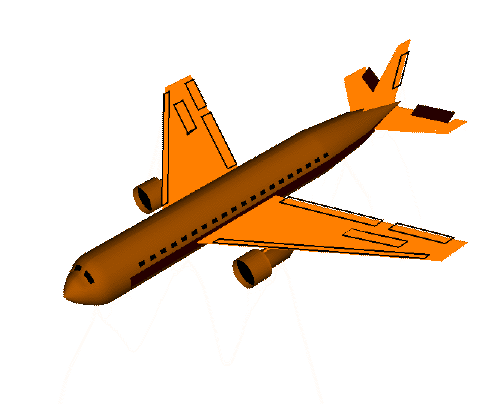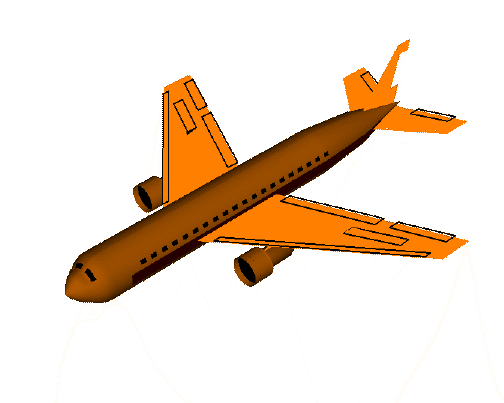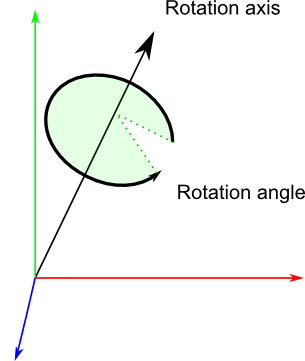全文转载自 https://www.cnblogs.com/21207-iHome/p/6894128.html
- RPY角与Z-Y-X欧拉角
描述坐标系{B}相对于参考坐标系{A}的姿态有两种方式。第一种是绕固定(参考)坐标轴旋转:假设开始两个坐标系重合,先将{B}绕{A}的X轴旋转γ
,然后绕{A}的Y轴旋转β,最后绕{A}的Z轴旋转α
,就能旋转到当前姿态。可以称其为X-Y-Z fixed angles或RPY角(Roll, Pitch, Yaw)。
Roll:横滚

Pitch: 俯仰

Yaw: 偏航(航向)

由于是绕固定坐标系旋转,则旋转矩阵为(cα
is shorthand for cosα, sα is shorthand for sinα
,and so on.)
RXYZ(γ,β,α)=RZ(α)RY(β)RX(γ)=⎡⎣⎢⎢cαcβsαcβ−sβcαsβsγ−sαcγsαsβsγ+cαcγcβsγcαsβcγ+sαsγsαsβcγ−cαsγcβcγ⎤⎦⎥⎥
另一种姿态描述方式是绕自身坐标轴旋转:假设开始两个坐标系重合,先将{B}绕自身的Z轴旋转α
,然后绕Y轴旋转β,最后绕X轴旋转γ
,就能旋转到当前姿态。称其为Z-Y-X欧拉角,由于是绕自身坐标轴进行旋转,则旋转矩阵为:
RZ′Y′X′(α,β,γ)=RZ(α)RY(β)RX(γ)=⎡⎣⎢⎢cαcβsαcβ−sβcαsβsγ−sαcγsαsβsγ+cαcγcβsγcαsβcγ+sαsγsαsβcγ−cαsγcβcγ⎤⎦⎥⎥
可以发现这两种描述方式得到的旋转矩阵是一样的,即绕固定坐标轴X-Y-Z旋转(γ,β,α)
和绕自身坐标轴Z-Y-X旋转(α,β,γ)
的最终结果一样,只是描述的方法有差别而已。In gerenal: three rotations taken about fixed axes yield the same final orientation as the same three rotations taken in opposite order about the axes of the moving frame.
- Axis-Angle与四元数
绕坐标轴的多次旋转可以等效为绕某一转轴旋转一定的角度。假设等效旋转轴方向向量为K⃗ =[kx,ky,kz]T
,等效旋转角为θ,则四元数q=(x,y,z,w)
,其中:
xyzw=kx⋅sinθ2=ky⋅sinθ2=kz⋅sinθ2=cosθ2
且有x2+y2+z2+w2=1

即四元数存储了旋转轴和旋转角的信息,它能方便的描述刚体绕任意轴的旋转。
四元数转换为旋转矩阵:
R=⎡⎣⎢⎢⎢1−2y2−2z22(xy+zw)2(xz−yw)2(xy−zw)1−2x2−2z22(yz+xw)2(xz+yw)2(yz−xw)1−2x2−2y2⎤⎦⎥⎥⎥
已知旋转矩阵为:

则对应的四元数为:

- 四元数与欧拉角的相互转换
定义两个四元数:
![]()
![]()
其中![]() 表示矢量
表示矢量
![]()
;而
![]()
表示矢量
![]()
四元数加法:
跟复数、向量和矩阵一样,两个四元数之和需要将不同的元素加起来。
![]()
加法遵循实数和复数的所有交换律和结合律。
四元数乘法:
四元数的乘法的意义类似于矩阵的乘法,可以表示旋转的合成。当有多次旋转操作时,使用四元数可以获得更高的计算效率。
![]()
![]()
由于四元数乘法的非可换性,pq并不等于qp,qp乘积的向量部分是:
![]()
Mathematica中有四元数相关的程序包Quaternions Package,需要先导入才能使用。下面计算了三个四元数的乘积:
<<Quaternions` (* This loads the package *) Quaternion[2, 1, 1, 3] ** Quaternion[2, 1, 1, 0] ** Quaternion[1, 1, 1, 1] (* Be sure to use ** rather than * when multiplying quaternions *)
计算结果为:Quaternion[-12, 4, 14, 2]
那么将Z-Y-X欧拉角(或RPY角:绕固定坐标系的X-Y-Z依次旋转α
,β,γ
角)转换为四元数:
q=⎡⎣⎢⎢⎢⎢⎢cosγ200sinγ2⎤⎦⎥⎥⎥⎥⎥⎡⎣⎢⎢⎢⎢⎢cosβ20sinβ20⎤⎦⎥⎥⎥⎥⎥⎡⎣⎢⎢⎢⎢cosα2sinα200⎤⎦⎥⎥⎥⎥=⎡⎣⎢⎢⎢⎢⎢⎢cosα2cosβ2cosγ2+sinα2sinβ2sinγ2sinα2cosβ2cosγ2−cosα2sinβ2sinγ2cosα2sinβ2cosγ2+sinα2cosβ2sinγ2cosα2cosβ2sinγ2−sinα2sinβ2cosγ2⎤⎦⎥⎥⎥⎥⎥⎥
根据上面的公式可以求出逆解,即由四元数q=(q0,q1,q2,q3)
或q=(w,x,y,z)
到欧拉角的转换为:
⎡⎣⎢⎢αβγ⎤⎦⎥⎥=⎡⎣⎢⎢⎢⎢arctan2(q0q1+q2q3)1−2(q21+q22)arcsin(2(q0q2−q1q3))arctan2(q0q3+q1q2)1−2(q22+q23)⎤⎦⎥⎥⎥⎥
由于arctan和arcsin的取值范围在−π2
和π2
之间,只有180°,而绕某个轴旋转时范围是360°,因此要使用atan2函数代替arctan函数:
⎡⎣⎢⎢αβγ⎤⎦⎥⎥=⎡⎣⎢⎢⎢atan2(2(q0q1+q2q3),1−2(q21+q22))arcsin(2(q0q2−q1q3))atan2(2(q0q3+q1q2),1−2(q22+q23))⎤⎦⎥⎥⎥
对于tan(θ) = y / x :
θ = ATan(y / x)求出的θ取值范围是[-PI/2, PI/2];
θ = ATan2(y, x)求出的θ取值范围是[-PI, PI]。
-
当 (x, y) 在第一象限, 0 < θ < PI/2
-
当 (x, y) 在第二象限 PI/2 < θ≤PI
-
当 (x, y) 在第三象限, -PI < θ < -PI/2
-
当 (x, y) 在第四象限, -PI/2 < θ < 0
将四元数转换为欧拉角可以参考下面的代码。需要注意欧拉角有12种旋转次序,而上面推导的公式是按照Z-Y-X顺序进行的,所以有时会在网上看到不同的转换公式(因为对应着不同的旋转次序),在使用时一定要注意旋转次序是什么。比如ADAMS软件里就默认Body 3-1-3次序,即Z-X-Z欧拉角,而VREP中则按照X-Y-Z欧拉角旋转。
enum RotSeq{zyx, zyz, zxy, zxz, yxz, yxy, yzx, yzy, xyz, xyx, xzy,xzx};
 View Code
View Code
上面的代码存在一个问题,即奇异性没有考虑。下面看一种特殊的情况(参考Maths - Conversion Quaternion to Euler):假设一架飞机绕Y轴旋转了90°(俯仰角pitch=90),机头垂直向上,此时如何计算航向角和横滚角?

这时会发生自由度丢失的情况,即Yaw和Roll会变为一个自由度。此时再使用上面的公式根据四元数计算欧拉角会出现问题:
arcsin(2(q0q2−q1q3))
的定义域为[−1,1],因此(q0q2−q1q3)∈[−0.5,0.5],当q0q2−q1q3=0.5时(在程序中浮点数不能直接进行等于判断,要使用合理的阈值),俯仰角β为90°,将其带入正向公式计算出四元数(q0,q1,q2,q3),然后可以发现逆向公式中atan2函数中的参数全部为0,即出现了00
的情况!无法计算。
β=π/2
时,sinβ2=cosβ2=0.707
,将其带入公式中有
q=⎡⎣⎢⎢⎢⎢wxyz⎤⎦⎥⎥⎥⎥⎡⎣⎢⎢⎢⎢⎢0.707(cosα2cosγ2+sinα2sinγ2)0.707(sinα2cosγ2−cosα2sinγ2)0.707(cosα2cosγ2+sinα2sinγ2)0.707(cosα2sinγ2−sinα2cosγ2)⎤⎦⎥⎥⎥⎥⎥=⎡⎣⎢⎢⎢⎢⎢0.707cosα−γ20.707sinα−γ20.707cosα−γ20.707sinα−γ2⎤⎦⎥⎥⎥⎥⎥
则xw=zy=tanα−γ2
,于是有
α−γ=2⋅atan2(x,w)
通常令α=0
,这时γ=−2⋅atan2(x,w)
。可以进行验证:当四元数为(w,x,y,z)=(0.653,-0.271,0.653,0.271)时,根据这些规则计算出来的ZYX欧拉角为α=0°,β=90°,γ=45°
当俯仰角为-90°,即机头竖直向下时的情况也与之类似,可以推导出奇异姿态时的计算公式。比较完整的四元数转欧拉角(Z-Y-X order)的代码如下:
CameraSpacePoint QuaternionToEuler(Vector4 q) // Z-Y-X Euler angles
{
CameraSpacePoint euler = { 0 };
const double Epsilon = 0.0009765625f;
const double Threshold = 0.5f - Epsilon;
double TEST = q.w*q.y - q.x*q.z;
if (TEST < -Threshold || TEST > Threshold) // 奇异姿态,俯仰角为±90°
{
int sign = Sign(TEST);
euler.Z = -2 * sign * (double)atan2(q.x, q.w); // yaw
euler.Y = sign * (PI / 2.0); // pitch
euler.X = 0; // roll
}
else
{
euler.X = atan2(2 * (q.y*q.z + q.w*q.x), q.w*q.w - q.x*q.x - q.y*q.y + q.z*q.z);
euler.Y = asin(-2 * (q.x*q.z - q.w*q.y));
euler.Z = atan2(2 * (q.x*q.y + q.w*q.z), q.w*q.w + q.x*q.x - q.y*q.y - q.z*q.z);
}
return euler;
}
在DirectXMath Library中有许多与刚体姿态变换相关的函数可以直接调用:
- 四元数乘法:XMQuaternionMultiply method --Computes the product of two quaternions.
- 旋转矩阵转四元数:XMQuaternionRotationMatrix method --Computes a rotation quaternion from a rotation matrix.
- 四元数转旋转矩阵:XMMatrixRotationQuaternion method -- Builds a rotation matrix from a quaternion.
- 欧拉角转四元数:XMQuaternionRotationRollPitchYaw method --Computes a rotation quaternion based on the pitch, yaw, and roll (Euler angles).
- 四元数转Axis-Angle:XMQuaternionToAxisAngle method --Computes an axis and angle of rotation about that axis for a given quaternion.
- 欧拉角转旋转矩阵:XMMatrixRotationRollPitchYaw method --Builds a rotation matrix based on a given pitch, yaw, and roll (Euler angles).
- Axis-Angle转旋转矩阵:XMMatrixRotationAxis method --Builds a matrix that rotates around an arbitrary axis.
- 构造绕X/Y/Z轴的旋转矩阵:XMMatrixRotationX method --Builds a matrix that rotates around the x-axis.(Angles are measured clockwise when looking along the rotation axis toward the origin)
下面的代码中坐标系绕X轴旋转90°(注意这里不是按照右手定则的方向,而是沿着坐标轴向原点看过去以顺时针方式旋转,因此与传统的右手定则刚好方向相反),来进行变换:
 View Code
View Code
结果如下图所示:

参考:
DirectXMath Library Quaternion Functions
Convert quaternion to euler rotations
Conversion between quaternions and Euler angles
Maths - Conversion Quaternion to Euler
Coordinate Transformations in Robotics—MATLAB
Introduction to Robotics - Mechanics and Control. Chapter 2 Spatial descriptions and transformations

